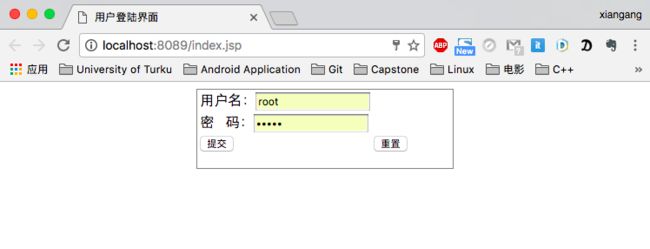写在前面:因为部门项目中有用户登录验证方面的需求,故而学习了一下相关的验证技术,本文仅是作者个人学习的心得,由于水平有限,如有错误之处还请指出、见谅。
1. 背景
在设计web应用的时候,用户登录/注册是必不可少的功能,对用户登录信息进行验证的方法也是多种多样,大致可以认为如下模式:前端验证+后台验证。根据笔者的经验,一般会在前端进行一些例如是否输入数据、输入的数据的格式是否正确等一系列的验证,在后台会查询数据库进行验证。
一般在后台进行验证的时候,都会选择使用Servlet的Filter作为拦截器,本文主要介绍Servlet的Filter,然后再拿它跟Spring MVC的HnadlerInterceptor进行对比。
2. Filter
2.1 什么是Filter
Servlet作为Java Web的基础,它的一个比较核心也被广泛应用的功能就是Filter,又叫拦截器。顾名思义,拦截器就是起到拦截作用的。一般情况下,用户从客户端发出请求到服务器后,整个的流程是:
HttpRequest ----> Filter ----> Servlet ----> Controller/Action/... ----> Filter ----> HttpResponse
根据上面的流程可以看出,Filter的作用就是在用户请求到达Servlet之前,进行拦截。在拦截到用户的请求后,我们可以实现一些自定义的业务逻辑,例如之前说到的对用户登录信息进行验证。Filter还可以在服务器响应到达客户端之前对响应的数据进行修改,本文主要介绍第一个功能。
2.2 Filter的工作原理
Filter跟Servlet一样都是由服务器负责创建和销毁的,在web应用程序启动时,服务器会根据应用程序的web.xml文件中的配置信息调用public void init(FilterConfig filterConfig) throws ServletException方法来初始化Filter,在web应用程序被移除或者是服务器关闭时,会调用public void destroy()来销毁Filter。在一个应用程序中一个Filter只会被创建和销毁一次,在进行完初始化之后,Filter中声明了public void doFilter(ServletRequest request, ServletResponse response, FilterChain chain) throws IOException, ServletException方法,用来实现一些需要在拦截完成之后的业务逻辑。
注意到上面的doFilter()方法的参数中,有chain这个参数,它是传递过来的拦截链对象,里面包含了用户定义的一系列的拦截器,这些拦截器根据其在web.xml中定义的顺序依次被执行。当用户的信息验证通过或者当前拦截器不起作用时,我们可以执行chain.doFilter()方法来跳过当前拦截器来执行拦截器链中的下一个拦截器。
2.3 自己实现Filter
自己实现Filter时,需要继承接口javax.servlet.Filter并且实现相关的方法。
2.3.1所用到的工具:
IDE: IntelliJ IDEA
构建工具:gradle
本地服务器:Tomcat
2.3.2 具体代码
build.gradle
group 'xiangang.wei'
version '1.0-SNAPSHOT'
apply plugin: 'java'
apply plugin: 'war'
sourceCompatibility = 1.8
repositories {
jcenter()
mavenCentral()
}
dependencies {
testCompile group: 'junit', name: 'junit', version: '4.11'
// servlet-api
compile group: 'javax.servlet', name: 'servlet-api', version: '2.5'
}
web.xml
loginValidation
filter.LoginValidation
redirectPath
/index.jsp
disableloginValidation
N
logonString
/index.jsp
loginValidation
/*
web.xml中redirectPath定义了当验证不成功时页面重定向的的路径,logonString定义了拦截器拦截的指定URL。/*表示拦截所有。它和之前定义的指定拦截的URL标签结合起来使用。
index.jsp
<%--
Created by IntelliJ IDEA.
User: xiangang
Date: 2016/11/21
Time: 下午3:42
To change this template use File | Settings | File Templates.
--%>
<%@ page contentType="text/html;charset=UTF-8" language="java" %>
用户登陆界面
Filter对应的实现类:
LoginValidation.java
package filter;
import javax.servlet.*;
import javax.servlet.http.HttpServletRequest;
import javax.servlet.http.HttpServletResponse;
import java.io.IOException;
/** *
Created by xiangang on 2016/11/21.
*/
public class LoginValidation implements Filter{
public FilterConfig config;
public static boolean isContains(String url, String[] regx){
boolean flag = false;
for (int i = 0;i登录成功之后的页面:
success.jsp
<%--
Created by IntelliJ IDEA.
User: xiangang
Date: 2016/11/21
Time: 下午3:56
To change this template use File | Settings | File Templates.
--%>
<%@ page contentType="text/html;charset=UTF-8" language="java" %>
登录成功!
欢迎!
配置好Tomcat之后,开启应用程序:
登录失败时不会跳转,仍然会停留在原页面。
3. Interceptor
之前提到的Filter是Servlet层面的拦截器,在许多的Java Web框架中,都实现了自己的拦截器Interceptor。例如Struts2中的Interceptor、Spring MVC中的HandlerInterceptor等。相比于Filter,框架中的Interceptor的产生作用的时间和位置不一样,下面描述了应用了Spring MVC中的HandlerInterceptor的web请求流程:
HttpRequest ----> DispactherServlet ----> HandlerInterceptor ---->Controller----> HandlerInterceptor ----> HttpResponse
两者的主要区别在于Filter起作用的时机是在请求到达Servlet之前,二HandlerInterceptor其作用的时机是在DispactherServlet接收到用户请求完成请求到相应的Handler映射之后。虽然都先于在具体的业务逻辑执行,但是还是存在一些差异。Filter面对的是所有的请求,而HandlerInterceptor是面对具体的Controller。Filter总是先于HandlerInterceptor发挥作用,在Filter中甚至可以中断请求,从而使它无法到达相应的Servlet。而且两者的配置也不一样,Filter是在web.xml中进行配置,HandlerInterceptor是在具体的applicationContext.xml中进行配置。
3.1 HandlerInterceptor的工作原理
分析源码,发现HandlerInterceptor接口中声明了如下几个方法:
public interface HandlerInterceptor {
/**
* Intercept the execution of a handler. Called after HandlerMapping determined
* an appropriate handler object, but before HandlerAdapter invokes the handler.
* DispatcherServlet processes a handler in an execution chain, consisting
* of any number of interceptors, with the handler itself at the end.
* With this method, each interceptor can decide to abort the execution chain,
* typically sending a HTTP error or writing a custom response.
*
Note: special considerations apply for asynchronous
* request processing. For more details see
* {@link org.springframework.web.servlet.AsyncHandlerInterceptor}.
* @param request current HTTP request
* @param response current HTTP response
* @param handler chosen handler to execute, for type and/or instance evaluation
* @return {@code true} if the execution chain should proceed with the
* next interceptor or the handler itself. Else, DispatcherServlet assumes
* that this interceptor has already dealt with the response itself.
* @throws Exception in case of errors
*/
boolean preHandle(HttpServletRequest request, HttpServletResponse response, Object handler) throws Exception;
/**
* Intercept the execution of a handler. Called after HandlerAdapter actually
* invoked the handler, but before the DispatcherServlet renders the view.
* Can expose additional model objects to the view via the given ModelAndView.
*
DispatcherServlet processes a handler in an execution chain, consisting
* of any number of interceptors, with the handler itself at the end.
* With this method, each interceptor can post-process an execution,
* getting applied in inverse order of the execution chain.
*
Note: special considerations apply for asynchronous * request processing. For more details see
* {@link org.springframework.web.servlet.AsyncHandlerInterceptor}.
* @param request current HTTP request
* @param response current HTTP response
* @param handler handler (or {@link HandlerMethod}) that started asynchronous
* execution, for type and/or instance examination
* @param modelAndView the {@code ModelAndView} that the handler returned
* (can also be {@code null})
* @throws Exception in case of errors
*/
void postHandle(HttpServletRequest request, HttpServletResponse response, Object handler, ModelAndView modelAndView) throws Exception;
/**
* Callback after completion of request processing, that is, after rendering
* the view. Will be called on any outcome of handler execution, thus allows
* for proper resource cleanup.
*
Note: Will only be called if this interceptor's {@code preHandle}
* method has successfully completed and returned {@code true}!
*
As with the {@code postHandle} method, the method will be invoked on each
* interceptor in the chain in reverse order, so the first interceptor will be
* the last to be invoked.
*
Note: special considerations apply for asynchronous
* request processing. For more details see
* {@link org.springframework.web.servlet.AsyncHandlerInterceptor}.
* @param request current HTTP request
* @param response current HTTP response
* @param handler handler (or {@link HandlerMethod}) that started asynchronous
* execution, for type and/or instance examination
* @param ex exception thrown on handler execution, if any
* @throws Exception in case of errors
*/
void afterCompletion(HttpServletRequest request, HttpServletResponse response, Object handler, Exception ex) throws Exception;
}
这三个方法分别会在具体的HandlerController方法执行之前,执行成功之后,和执行完成之后被执行。
3.2 自己实现HandlerInterceptor
Spring MVC框架采用了适配器的开发模式,使用一个抽象的类HandlerInterceptorAdapter实现HandlerInterceptor接口,这样当我们需要自己实现HandlerInterceptor时,我们可以继承HandlerInterceptorAdapter这样我们就不用全部实现这三个方法,而可以选择性的实现自己需要的方法。
3.2.1所用到的工具:
IDE: IntelliJ IDEA
构建工具:gradle
本地服务器:Tomcat
3.2.2具体的代码:
build.gradle
group 'xiangang.wei'
version '1.0-SNAPSHOT'
apply plugin: 'java'
apply plugin: 'war'source
Compatibility = 1.8
repositories {
jcenter()
mavenCentral()
}
dependencies {
testCompile group: 'junit', name: 'junit', version: '4.11'
// servlet-api
compile group: 'javax.servlet', name: 'servlet-api', version: '2.5'
//spring相关
compile group: 'org.springframework', name: 'spring-webmvc', version: '4.3.3.RELEASE'
compile group: 'org.springframework', name: 'spring-orm', version: '4.3.3.RELEASE'
compile group: 'org.springframework', name: 'spring-aspects', version: '4.3.3.RELEASE'
compile group: 'org.springframework.security', name: 'spring-security-config', version: '3.2.0.RELEASE'
compile group: 'org.springframework.security', name: 'spring-security-taglibs', version: '3.2.0.RELEASE'
compile 'org.springframework.security:spring-security-web:3.2.0.RELEASE' //hibernate相关
compile 'org.hibernate:hibernate-core:4.3.6.Final'
//mysql
compile group: 'mysql', name: 'mysql-connector-java', version: '5.1.39'
//springData
compile group: 'org.springframework.data', name: 'spring-data-jpa', version: '1.10.3.RELEASE'
// https://mvnrepository.com/artifact/log4j/log4j日志
compile group: 'log4j', name: 'log4j', version: '1.2.17'
//json解析相关
compile group: 'com.fasterxml.jackson.core', name: 'jackson-databind', version: '2.5.4'
compile group: 'com.fasterxml.jackson.core', name: 'jackson-core', version: '2.5.4'
}
web.xml
contextConfigLocation
classpath:databaseAccess.xml,classpath:service.xml
org.springframework.web.context.ContextLoaderListener
CharacterEncodingFilter
org.springframework.web.filter.CharacterEncodingFilter
encoding
utf-8
CharacterEncodingFilter
/*
dispatcherServlet
org.springframework.web.servlet.DispatcherServlet
contextConfigLocation
classpath:dispatcherServlet.xml
1
dispatcherServlet
/
涉及到HandlerInterceptor的配置文件dispatcherServlet.xml
配置HandlerInterceptor有两种方式,一种是如上面所示,这张方式配置的HandlerInterceptor可以指定具体的拦截路径,另外一种方式是直接在
具体的Interceptor实现类:
LoginInterceptor.java
package ims.handlerInterceptor;
import ims.service.UserService;
import org.springframework.beans.factory.annotation.Autowired;
import org.springframework.stereotype.Controller;
import org.springframework.stereotype.Service;
import org.springframework.web.servlet.handler.HandlerInterceptorAdapter;
import javax.servlet.http.HttpServletRequest;
import javax.servlet.http.HttpServletResponse;
import javax.servlet.http.HttpSession;
/**
* Created by xiangang on 16/11/17.
*/
public class LoginInterceptor extends HandlerInterceptorAdapter {
@Autowired
private UserService userService;
@Override
public boolean preHandle(HttpServletRequest request, HttpServletResponse response, Object handler) throws Exception {
boolean flag = true;
HttpSession session = request.getSession();
if (session.getAttribute("user") == null) {
String userName = request.getParameter("userName");
String password = request.getParameter("password");
flag = userService.selectByUserName(userName, password);
if (flag){
session.setAttribute("user",userName);
}
}
if (!flag){
response.sendRedirect("index.jsp");
}
return flag;
}
}
后续的其他代码这里就不一一贴出相关代码在:https://github.com/xiangang-wei/Inteceptor
具体的运行结果这里也就不再贴图了,实现的效果跟之前的Filter是一致的。
3. 总结
本文主要是对自己在项目中使用的相关技术进行总结,关于这个知识点还有很多内容没有覆盖到,读者如有兴趣,可以查看相关源码进行分析。

